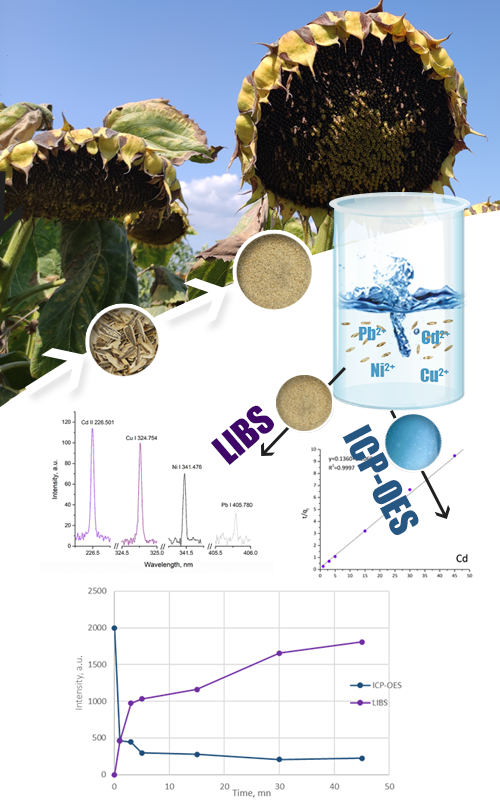Removal of heavy metals from aqueous media by sunflower husk: A comparative study of biosorption efficiency by using ICP-OES and LIBS Scientific paper
Main Article Content
Abstract
Presented research aimed to develop an alternative approach for the estimation of biosorption capability of sunflower husk. The acid-pretreated sunflower biomass was characterized by scanning electron microscopy combined with energy dispersive X-Ray spectroscopy (SEM-EDX) analysis and Fourier transform infrared (FTIR) spectroscopy. Biosorption efficiency has been evaluated using inductively coupled plasma optical emission spectroscopy (ICP-OES) and laser-induced breakdown spectroscopy (LIBS). The adsorption capacity of the adsorbent was determined as the function of the pH of the solution, the initial concentration of heavy metal solutions, and contact time. The optimal conditions were achieved after 15 min of contact at pH 6, while the percentage of the removal was from 80.0–98.7 %, depending on the element. The results obtained from the kinetic and isotherm studies show that maximum adsorption of ions was quickly reached and followed the pseudo-second-order kinetic model. Real samples were tested and obtained Ni values by LIBS method were 3100±200 and 1240±100 mg kg-1, while estimated values by the ICP-OES were 2995±20 and 1130±10 mg kg-1, respectively. The obtained results prove that LIBS method can be used as a “green alternative“ for the evaluation of biosorption efficiency.
Downloads
Metrics
Article Details

This work is licensed under a Creative Commons Attribution-NonCommercial-NoDerivatives 4.0 International License.

Authors retain copyright and grant the journal right of first publication with the work simultaneously licensed under a Creative Commons Attribution license 4.0 that allows others to share the work with an acknowledgement of the work's authorship and initial publication in this journal.
Funding data
-
Ministarstvo Prosvete, Nauke i Tehnološkog Razvoja
Grant numbers 451-03-68/2022-14/200017; 451-03-68/2022-14/200168
References
P. B. Tchounwou, C. G. Yedjou, A. K. Patlolla, D. J. Sutton, EXS 101 (2012) 133 (https://doi.org/10.1007/978-3-7643-8340-4_6)
M. Jalali, F. Aboulghazi, J. Mater. Cycles Waste Manage. 15 (2013) 548 (https://doi.org/10.1007/s10163-012-0096-3)
A. M. Hamdan, H. Abd-El-Mageed, N. Ghanem, Sci. Rep. 11 (2021) 9314 (https://doi.org/10.1038/s41598-021-88843-y)
I. Michalak, K. Chojnacka, A. Witek-Krowiak, Appl. Biochem. Biotechnol. 170 (2013) 1389 (https://doi.org/10.1007/s12010-013-0269-0)
A. Othmani, S. Magdouli, P. Senthil Kumar, A. Kapoor, P. V. Chellam, Ö. Gökkuş, Environ. Res. 204 (2022) 111916 (https://doi.org/10.1016/j.envres.2021.111916)
A. Ali Redha, Arab J. Basic Appl. Sci. 27 (2020) 183 (https://doi.org/10.1080/25765299.2020.1756177)
A. Robalds, G. M. Naja, M. Klavins, J. Hazard. Mater. 304 (2016) 553 (https://doi.org/10.1016/j.jhazmat.2015.10.042)
D. Sud, G. Mahajan, M. P. Kaur, Bioresour. Technol. 99 (2008) 6017 (https://doi.org/10.1016/j.biortech.2007.11.064)
Y. Kaya, Agric. For. 60 (2014) 95 (https://dergipark.org.tr/en/pub/ssrj/issue/32264/343313)
S. Stankovic, T. Sostaric, M. Bugarcic, A. Janicijevic, K. Pantovic-Spajic, Z. Lopicic, Acta Period. Technol. (2019) 268 (https://doi.org/10.2298/APT1950268S)
M. Jaishankar, T. Tseten, N. Anbalagan, B. B. Mathew, K. N. Beeregowda, Interdiscip. Toxicol. 7 (2014) 60 (https://doi.org/10.2478/intox-2014-0009)
S. L. R. K. Kanamarlapudi, V. K. Chintalpudi, S. Muddada, in Biosorption, InTech, Rijeka, 2018 (https://doi.org/10.5772/intechopen.77315)
S. A. Abdulhussein, A. I. Al wared, Assoc. Arab Univ. J. Eng. Sci. 26 (2019) 35 (https://doi.org/10.33261/jaaru.2019.26.1.005)
M. M. el-Halwany, J. Chromatogr. Sep. Tech. 04 (2013) 183 (https://doi.org/10.4172/2157-7064.1000183)
I. Anastopoulos, J. O. Ighalo, C. Adaobi Igwegbe, D. A. Giannakoudakis, K. S. Triantafyllidis, I. Pashalidis, D. Kalderis, J. Mol. Liq. 342 (2021) 117540 (https://doi.org/10.1016/j.molliq.2021.117540)
K. Chojnacka, M. Samoraj, Ł. Tuhy, I. Michalak, M. Mironiuk, M. Mikulewicz, Molecules 23 (2018) 2076 (https://doi.org/10.3390/molecules23082076)
I. Michalak, K. Chojnacka, K. Marycz, Microchim. Acta 172 (2011) 65 (https://doi.org/10.1007/s00604-010-0468-0)
R. Gaudiuso, M. Dell’Aglio, O. De Pascale, G. S. Senesi, A. De Giacomo, Sensors 10 (2010) 7434 (https://doi.org/10.3390/s100807434)
M. Momcilovic, M. Kuzmanovic, D. Rankovic, J. Ciganovic, M. Stoiljkovic, J. Savovic, M. Trtica, Appl. Spectrosc. 69 (2015) 419 (https://doi.org/10.1366%2F14-07584)
S. Zivkovic, J. Savovic, M. Trtica, J. Mutic, M. Momcilovic, J. Alloys Compd. 700 (2017) 175 (https://doi.org/10.1016/j.jallcom.2017.01.060)
S. Zivkovic, J. Savovic, M. Kuzmanovic, J. Petrovic, M. Momcilovic, Microchem. J. 137 (2018) 410 (https://doi.org/10.1016/j.microc.2017.11.020)
A. Gałuszka, Z. Migaszewski, J. Namieśnik, TrAC Trends Anal. Chem. 50 (2013) 78 (https://doi.org/10.1016/j.trac.2013.04.010)
K. D. Kowanga, E. Gatebe, G. O. Mauti, E. M. Mauti, J. Phytopharm. 5 (2016) 71 (https://doi.org/10.31254/phyto.2016.5206)
S. Zivkovic, M. Momcilovic, A. Staicu, J. Mutic, M. Trtica, J. Savovic, Spectrochim. Acta, B 128 (2017) 22 (https://doi.org/10.1016/j.sab.2016.12.009)
M. Tammer, Colloid Polym. Sci. 283 (2004) 235 (https://doi.org/10.1007/s00396-004-1164-6)
K. Sarkanen, H.-M. Chang, B. Ericsson, Tappi 50 (1967) 572
S. G. Wi, E. J. Cho, D. S. Lee, S. J. Lee, Y. J. Lee, H. J. Bae, Biotechnol. Biofuels 8 (2015) 228 (https://doi.org/10.1186/s13068-015-0419-4)
Nu, Hung, Hoang, Van der Bruggen, Appl. Sci. 9 (2019) 3347 (https://doi.org/10.3390/app9163347)
Y. Du, F. Lian, L. Zhu, Environ. Pollut. 159 (2011) 1763 (https://doi.org/10.1016/j.envpol.2011.04.017)
F. Ogata, M. Kangawa, H. Tominaga, Y. Tanaka, A. Ueda, Y. Iwata, N. Kawasaki, J. Oleo Sci. 62 (2013) 949 (https://doi.org/10.5650/jos.62.949)
A. Buasri, N. Chaiyut, K. Tapang, S. Jaroensin, S. Panphrom, APCBEE Procedia 3 (2012) 60 (https://doi.org/10.1016/j.apcbee.2012.06.046).





